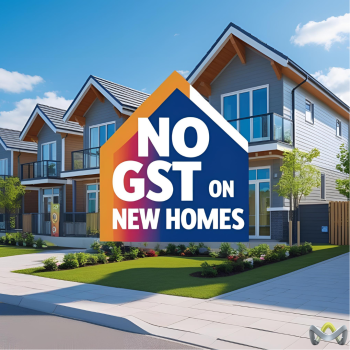No GST for First Time Homebuyers buying Brand New
  

🏡 Major GST Break for First-Time Home Buyers: A Game Changer for Canadians
As of May 27, 2025, the Canadian government has introduced a significant incentive for first-time home buyers: a full rebate of the 5% Goods and Services Tax (GST) on new homes priced up to $1 million. For homes valued between $1 million and $1.5 million, the rebate is phased out linearly—for example, a home priced at $1.25 million would be eligible for a 50% GST rebate. You may be surprised that in this case the definition of a First time Home Buyer does not mean never having owned a home....
To be considered a “first-time home buyer” for the purposes of the FTHB GST Rebate, an individual would generally need to meet the following conditions:
be at least 18 years of age;
be either a Canadian citizen or a permanent resident of Canada; and
not have lived in a home, whether in or outside Canada, that they owned or that their spouse or common-law partner owned in the calendar year or in the four preceding calendar years.
Why This Matters:
Substantial Savings: This rebate can save first-time buyers up to $50,000, making homeownership more attainable.
Boost to New Home Construction: By incentivizing the purchase of new homes, this measure aims to stimulate the construction industry and increase housing supply across Canada.
Broader Eligibility: Unlike previous rebates limited to homes under $450,000, this new policy reflects current market realities, especially in high-cost areas.
Eligibility Highlights:
Must be a first-time home buyer (per the definition mentions above.
The home must be a new construction intended as the primary residence.
The agreement of purchase and sale must be entered into between May 27, 2025, and 2031, with construction beginning before 2031 and completion before 2036.
This initiative is a significant step toward making homeownership more accessible for Canadians, particularly in markets where affordability has been a longstanding challenge.
For more details on the rebate and how to apply, visit the official government announcement: (Canada.ca)
Understanding Fixed and Variable Mortgage Rates: What’s Right for You in Today’s Market?
  

When it comes to choosing a mortgage, one of the most important decisions to consider is deciding between a fixed-rate and a variable-rate mortgage. Both options have their benefits, but the best choice depends on your financial goals, tolerance for risk, and the current economic climate. Let’s break it down:
Fixed-Rate Mortgages
A fixed-rate mortgage locks in your interest rate for the duration of your term, usually 1 to 5 years.
Benefits:
Predictability: Your monthly payments stay the same, which makes budgeting easier.
Stability: You’re protected from interest rate hikes, providing peace of mind.
Ideal for Long-Term Planning: If you plan to stay in your home for a while or prefer financial consistency, this option is great for you.
Drawbacks:
Fixed rates are often higher than variable rates at the start of the term. You might miss out on savings if rates drop during your term.
Variable-Rate Mortgages
Variable-rate mortgages, on the other hand, have an interest rate that fluctuates with changes to your lender's prime rate.
Benefits:
Lower Initial Rates: Historically, variable rates tend to be lower than fixed rates.
Potential Savings: If interest rates decrease, you benefit from lower monthly payments.
Flexibility: Variable-rate mortgages often have lower penalties if you choose to break your term early.
Drawbacks:
Payments can increase if interest rates rise, leading to unpredictability. Not ideal for those who prefer financial stability or have a tight budget.
Let’s Talk About Your Goals
Every borrower’s situation is unique. Whether you’re a first-time homebuyer or looking to refinance, I’d love to discuss your options and help you choose the best mortgage strategy for your needs.
Feel free to reach out for a personalized consultation—I’m here to help you make informed decisions with confidence.
Newsletter Challenge
  

This newsletter's question: What year was Earth Day first celebrated?
(Try not to google the answer;)
As always, the first person to text or email me the correct answer wins a $20 Guusto Gift Card to use wherever you want!
|